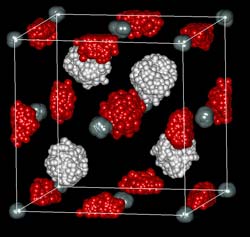Unveiling the behaviour of hydrogen molecules

Dr William Yim had the opportunity to collaborate with Toshiaki Iitaka from Riken Advanced Science Institute and Prof John Tse from Canada’s University of Saskatchewan last year.
The team of researchers discovered the physical basis to explain the newly discovered vibration behavior of molecular hydrogen, including ‘silane’ – hydrogen bound to silicon, under high pressure.
The two-month project resulted in a paper, ‘Pressure-induced intermolecular interactions in crystalline silane-hydrogen’, that was published in Physical Review Letters 105.
The cross-disciplinary team was like a dream team, made possible by the mutual introductions given by Prof John Tse and Dr Wu Ping, IHPC’s Director of Material Science and Engineering Department.
“Prof. John Tse’s expertise is on experimental and computational research on materials science and he is famous in high pressure research field” said William. “Dr. Toshiaski Iitaka is a permanent staff member at Riken working on solid state research and program development for linear scaling computational method.”
As William himself has a track record on ab initio vibrational frequency calculations applying to surface science, it was a good match of expertise.
His motto is “Be Prepared”, so the challenge of taking on the project was a welcome one.
“I like to learn new skills, and I made sure I learnt all the necessary computational techniques before this project. Good preparation and speed are the key factors in benefitting from such a good opportunity.”
It was a classic collaboration case study, in which everyone played an important role in making the breakthrough.
“When Prof. Tse mentioned an interesting problem of H2 vibron softening, we were well prepared to puzzle out the scientific question” William said.
William contributed the ‘Donor-acceptor interaction in compression regime’, which is a brand new idea.
The team performed molecular dynamic simulations to study the interactions between hydrogen and silane molecules, which gave a better fundamental understanding for the materials under extreme conditions.
The results provided a good basis to potentially develop a hydrogen economy.
William said “the knowledge of physical interaction in compressed regimes, as indicated by vibrational spectroscopy and chemical bonding, will be very helpful for further engineering the mixing process and hence the H2 transport capability.”
The project is another feather in the cap for IHPC.
Dr Toshiaki Itaka, from Riken’s Computational Astrophysics Laboratory commented: “It was an exciting experience that I could work with William and IHPC for the study of SiH4 under pressure. As a physicist, I learned a lot from the chemist's viewpoint of William.”
“I also noted that IHPC has strength not only in academic research but also in its application to important problems in real world. This is what Riken is aiming at, and would like to learn from IHPC.”
William too had an enriching experience working closely with the other researchers, commenting “the most important skill I’ve learnt is to understand how to translate research work into an impactful and engaging story. It is an art to turn lots of boring numbers into an interesting story so that people can understand the significance of the discovery.”
Media Contact
All latest news from the category: Information Technology
Here you can find a summary of innovations in the fields of information and data processing and up-to-date developments on IT equipment and hardware.
This area covers topics such as IT services, IT architectures, IT management and telecommunications.
Newest articles

Properties of new materials for microchips
… can now be measured well. Reseachers of Delft University of Technology demonstrated measuring performance properties of ultrathin silicon membranes. Making ever smaller and more powerful chips requires new ultrathin…

Floating solar’s potential
… to support sustainable development by addressing climate, water, and energy goals holistically. A new study published this week in Nature Energy raises the potential for floating solar photovoltaics (FPV)…

Skyrmions move at record speeds
… a step towards the computing of the future. An international research team led by scientists from the CNRS1 has discovered that the magnetic nanobubbles2 known as skyrmions can be…





















